Oregon sparkling wine is growing in the world of wine. An increasing number of wineries are crafting sparkling wine, and the quality coming from the region is outstanding.
During my recent visit to the Columbia Gorge AVA, I had the privilege of meeting a pioneer of the Oregon sparkling wine movement, Rich Cushman of Viento Wines. He was accompanied by Steve Bickford of Mt. Hood Winery. Together they led us through a tasting of Oregon sparkling wines as we enjoyed some fresh mountain air and beautiful scenery near the base of Mt. Hood.
Rich and Steve are former high school classmates who both found their way into the wine business later in life. Rich serves as the winemaker for both Viento and Mt. Hood wineries (in addition to others!) and has a passion for sparkling wine. He began making sparkling wine in 1982, long before the Oregon sparkling wine scene took off.
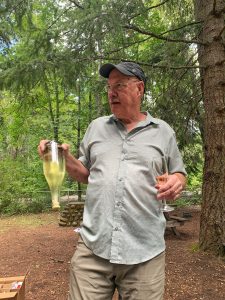
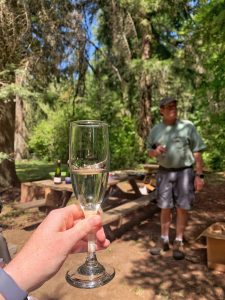
If you’re not already familiar with Oregon sparkling wine, my bet is that you will start to hear more about it in the months and years to come.
Sparkling wine is not the same as Champagne—only wine made in Champagne, France can be called Champagne. However, Oregon is producing sparkling wines that are on par with some of the great Champagnes of the world. How is that so? Well, it all comes down to a little thing called geography. (Bear with me for a minute here while we get a little geeky.)
Here’s why Oregon and Champagne are more similar than you think…
There are three types of grapes that are permitted in the production of Champagne: Pinot Noir, Chardonnay, and Pinot Meunier (or Meunier for short). The cool climate region of Champagne, France (located at approximately 48 degrees North latitude) allows grapes to retain acidity during their long growing season. Good acidity and balanced sugars are essential to the production of fine sparkling wines. Pinot Noir, Chardonnay, and Meunier would not produce the appropriate levels of acid and sugar if they were to be grown in a warmer climate region of the world. As a result, the geographical location of Champagne is a primary factor in what makes Champagne world-renowned in quality. Good quality limestone soils also influence the flavor of Champagne’s grapes.
Now, let’s talk about Oregon. Most of Oregon’s winegrowing region is located at 45 degrees North latitude. In fact, it is parallel to Burgundy, France, another renowned winegrowing region. While Oregon is a few degrees closer to the equator, it has already proven that it can produce some of the finest examples of Pinot Noir and Chardonnay. The EU PGI designation proves it! And if Oregon has prime examples of the two main grapes used in the production of Champagne, it seems natural that Oregon winemakers jump on the sparkling wine train.
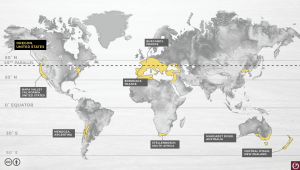
Oregon sparkling wine is unique because winemakers are not limited to using only Pinot Noir, Chardonnay, or Meunier grapes.
In fact, one of my favorite sparkling wines from Viento Wines was the Cuvée Diamante, an extra dry sparkling wine made from Riesling grapes. (Fun fact: Winemaker Rich Cushman planted the first Riesling grapes in the Columbia Gorge region!). Flavors of cooked apple and fresh pear combined perfectly with delicate bubbles, high acidity, and fragrant fruit and floral aromas. Not only was this a unique sparkling wine, but it was perfectly balanced and a prime example of the potential that Oregon sparkling wine has to offer.
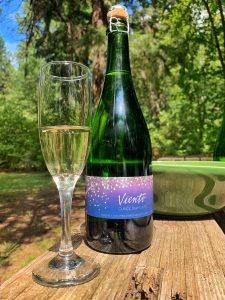
The soil composition in Oregon is comprised of volcanic sediment, along with silt and sand.
The Missoula Floods, which is estimated to have occurred between 15,000-13,000 years ago, deposited a range of soils and sediments that now contribute to the outstanding flavors of wine grapes grown in Oregon. While different in soil composition compared to Champagne, Oregon soils contribute to the complexity and balance that the region has become known for in recent years.

During our tasting, we also sampled the Viento Cuvée Tradition Brut Rosé—a favorite wine of Rich’s, and rightly so.
For consumers who prefer a sparkling wine with more autolytic flavors, this Rosé is sure to satisfy. Aromas consist of almond, strawberry, peach, and biscuit. This Rosé spends 22 months on its lees (aka the yeast that eats the sugars and produces alcohol in the wine), which gives the toasty, biscuit quality on the nose and palate.
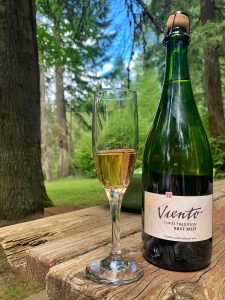
Last but not least, we sampled the first sparkling wine ever produced at Mt. Hood Winery: the Van Horn Estate Vineyard Estate Brut Cuvée.
Despite it being the first release, this wine secured a Double Gold award in the Best Sparkling Wine category at the Cascadia International Wine Competition in 2021. Compliments to both Steve’s vineyard and Rich’s winemaking! This Cuvée exhibited pear, apple, and lemon aromas that felt reminiscent of a classic, well-balanced sparkling wine from France.
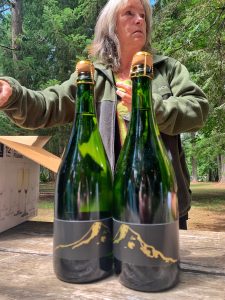
While Rich makes his wines using the traditional method, he did introduce us to a modern development in the world of sparkling wine: yeast beads!
These little beads contain yeast strains that aid in the bottle fermentation of the sparkling wine. They are delicately added to the base wine, which is then crown-capped and stored for the fermentation process. One of the benefits of using yeast beads is that they simplify the process of disgorgement. (When using the traditional form of yeast, lees settle in the neck of the bottle which is then frozen. Disgorgement occurs when the crown cap is popped off of the bottle to release the frozen yeast plug. It is a labor-intensive and messy process!)
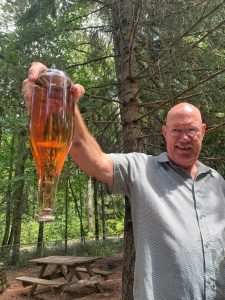
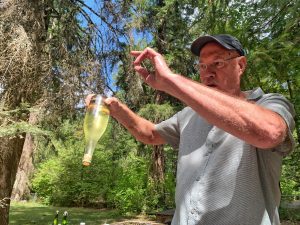
The quality of these three Oregon sparkling wines rivals any domestic or international sparkling wine on the market.
They could easily stand alongside some of the most popular Champagne producers, too. Viento Wines and Mt. Hood Winery are not only putting Oregon sparkling wine on the map, but are showcasing the outstanding quality of wines produced in the boutique winemaking region of the Columbia Gorge AVA.
After sipping on some sparkling wine and enjoying conversations with Rich and Steve, it was time for us to load into Martin’s van and head to our next destination: Stave and Stone Wine Estates. Rich Cushman is also the winemaker for Stave and Stone, which meant we got to experience even more of his winemaking talents.
Stay tuned for my next blog post featuring fabulous Pinot Noirs (among other wines!) that we sampled at Stave and Stone Wine Estates. In the meantime, do yourself a favor and order some Oregon sparkling wine from Rich and Steve. Both Viento and Mt. Hood Winery ship direct to consumer and are very affordably priced for the quality of wine they offer.
For a full list of recommendations for your visit to the Columbia Gorge AVA, check out the links below!
Accommodations: Best Western Plus Hood River Inn
Transportation: Martin’s Gorge Tours
Tasting Rooms:
- Phelps Creek Vineyards: Estate grown, high quality Pinot Noir, Chardonnay, & Pinot Gris
- Cathedral Ridge Winery: Home to big, bold Oregon red wines, signature blends, and delicious whites
- Viento Wines: A pioneer of the Gorge wine region known for Pinot Noir, Riesling, and sparkling wines
- Mt. Hood Winery: Featuring a broad selection of wines, including an award-winning sparkling wine
- Stave & Stone Wine Estates: “Wines with Personality”, accompanied by spectacular views of Mt. Hood and Mt. Adams from the tasting room
- Wy’East Vineyards: Estate-grown wines for every palate, from single varietals to blends
- Peter Cushman Wines: Third-generation wine maker whose passion exudes from his top-quality, small production wines
